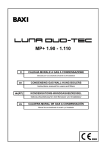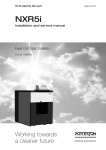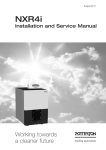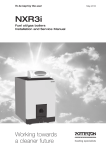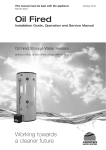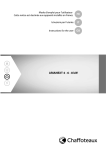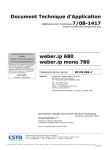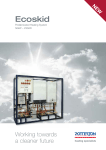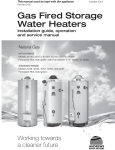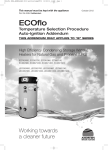Download AMX AVS-OP-2004-110 Instruction manual
Transcript
To be kept by the user November 2013 Sirius two WH 90 & 110 kW Instruction manual for users and fitters Working towards a cleaner future heating specialists Dear Customer, Our company is confident our new product will meet all your requirements. Buying one of our products guarantees all your expectations: good performance combined with simple and rational use. Please do not put this booklet away without reading it first: it contains useful information for the correct and efficient use of your product. Our company declares that these products are marked following Directives: in compliance with the essential requirements of the - Gas Directive 2009/142/EC - Efficiency Directive 92/42/EEC - Electromagnetic Compatibility Directive 2004/108/EC U s e r & I n s t a l l e r ( e n ) - Low Voltage Directive 2006/95/EC Our company, constantly striving to improve the products, reserves the right to modify the details given in this documentation at any time and without notice. These Instructions are only meant to provide consumers with use information and under no circumstance should they be construed as a contract with a third party. CONTENT 1. 1.1 1.2 2. 3. 4. 5. 6. 7. 8. 9. 9.1 10. 10.1 10.2 11. 11.1 11.2 12. 12.1 12.2 12.3 13. 14. 15. 15.1 16. 17. 18. 18.1 18.2 18.3 18.4 19. DESCRIPTION OF SYMBOLS ..........................................................................................................................................3 SAFETY WARNINGS..........................................................................................................................................................3 GENERAL PRECAUTIONS ...............................................................................................................................................4 ENERGY-SAVING TIPS......................................................................................................................................................4 COMMISSIONING THE BOILER........................................................................................................................................5 ADJUSTING THE CH AND DHW FLOW TEMPERATURE.................................................................................................5 OPERATING MODES.........................................................................................................................................................5 PROLONGED SHUTDOWN. FROST PROTECTION.........................................................................................................6 GAS CONVERSION............................................................................................................................................................6 FAULTS...............................................................................................................................................................................6 BOILER INFORMATION MENU .........................................................................................................................................6 FILLING THE SYSTEM.......................................................................................................................................................7 ROUTINE MAINTENANCE INSTRUCTIONS.....................................................................................................................7 SWITCHING OFF THE BOILER.........................................................................................................................................7 INSTRUCTIONS PRIOR TO INSTALLATION.....................................................................................................................8 INSTALLING THE BOILER..................................................................................................................................................8 BOILER PUMP....................................................................................................................................................................8 INSTALLING THE FLUES...................................................................................................................................................9 CONCENTRIC FLUES........................................................................................................................................................9 CASCADE FLUES...............................................................................................................................................................9 ELECTRICAL CONNECTIONS...........................................................................................................................................10 CONNECTING THE ROOM THERMOSTAT.......................................................................................................................11 ACCESSORIES NOT INCLUDED IN THE SUPPLY...........................................................................................................11 SETTING PARAMETERS USING THE REMOTE CONTROL............................................................................................11 OUTDOOR SYSTEM MANAGEMENT MODULES.............................................................................................................13 SPECIAL FUNCTIONS........................................................................................................................................................14 SYSTEM AIR EXTRACTION FUNCTION...........................................................................................................................14 COMMISSIONING FUNCTION...........................................................................................................................................14 CHIMNEY SWEEP MODE..................................................................................................................................................14 FAULTS THAT CANNOT BE RESET BY THE USER..........................................................................................................14 PARAMETER SETTINGS...................................................................................................................................................14 GAS VALVE COMMISSIONING..........................................................................................................................................16 GAS CONVERSION............................................................................................................................................................16 ADJUSTMENT AND SAFETY DEVICES............................................................................................................................17 PUMP CAPACITY/ HEAD....................................................................................................................................................17 ANNUAL SERVICING.........................................................................................................................................................18 CLEAN THE HEAT EXCHANGER......................................................................................................................................18 CHECKING THE BURNER.................................................................................................................................................18 CLEANING THE CONDENSATE TRAP..............................................................................................................................19 COMBUSTION PARAMETERS...........................................................................................................................................19 TECHNICAL SPECIFICATIONS..........................................................................................................................................20 7108686.02 (1-11/12) 2 DESCRIPTION OF SYMBOLS WARNING Risk of damage to or malfunction of the appliance. Pay special attention to the warnings concerning danger to people. DANGER OF BURNS Wait for the appliance to cool down before working on the parts exposed to heat. DANGER - HIGH VOLTAGE Live components - electrocution hazard. DANGER OF FREEZING Possible formation of ice due to low temperatures. IMPORTANT INFORMATION Information to read with particular care as it is useful for the correct operation of the boiler. GENERIC PROHIBITION It is forbidden to do/use the things indicated alongside the symbol. SAFETY WARNINGS SMELL OF GAS • • • • Switch off the boiler. Do not activate any electrical device (such as switching on the light). Put out any naked flames and open the windows. Call an Authorised Service Engineer. SMELL OF COMBUSTION FUMES • Switch off the boiler. • Open all the doors and windows to ventilate the room. • Call an Authorised Service Engineer. FLAMMABLE MATERIAL Do not use and/or store highly flammable material (thinners, paper, etc.) near the boiler. SERVICING AND CLEANING THE BOILER Switch off the boiler before working on it. The appliance is not intended to be used by persons with reduced physical, sensory or mental capacities, or who lack experience or knowledge, unless, through the mediation of a person responsible for their safety, they have had the benefit of supervision or of instructions on the use of the appliance. 3 7108686.02 (1-11/12) U s e r & I n s t a l l e r ( e n ) GENERAL PRECAUTIONS This boiler has been designed to heat water to a temperature lower than boiling point at atmospheric pressure. It must be connected to a central heating system and to a domestic hot water supply system according to its performance and power output. Before having the boiler installed by a qualified service engineer, make sure the following operations are performed: • Make sure that the boiler is adjusted to use the type of gas delivered by the gas supply. To do this, check the markings on the packaging and the rating plate on the appliance. • Make sure that the flue terminal draft is appropriate, that the terminal is not obstructed and that no exhaust gases from other appliances are expelled through the same flue duct, unless the latter has been specially designed to collect exhaust gas from more than one appliance, in compliance with current laws and regulations. • Make sure that, if the boiler is connected to existing flue ducts, these have been thoroughly cleaned as residual products of combustion may detach from the walls during operation and obstruct the flow of fumes. • The use of a chimney liner is required for condensing boiler. • To ensure correct operation and maintain the warranty, observe the following precautions: 1. DHW circuit 1.1 If the water is harder than 15 °F (1 °F = 10 mg calcium carbonate per litre of water), install a polyphosphate dispenser or an equivalent treatment system, compliant with current regulations. 1.2 Thoroughly flush the system after installation of the appliance and before use. 1.3 The materials used for the DHW circuit must comply with Directive 98/83/EC. 2. Heating circuit U s e r & I n s t a l l e r ( e n ) 2.1 New system: Before installing the boiler, the system must be cleaned and flushed to eliminate residual thread-cutting swarf, solder and any solvents, using suitable off-the-shelf non-acid and non-alkaline products that do not damage metal, plastic and rubber parts. To protect the system from scale, use inhibitors such as SENTINEL X100 and FERNOX protector for heating circuits. Use these products in strict compliance with the manufacturers’ instructions. 2.2 Existing system: Before installing the boiler, drain the system and clean it to remove sludge and contaminants, using suitable proprietary products. Recommended cleaning products are: SENTINEL X300 or X400 and FERNOX regenerator for heating circuits. Use these products in strict compliance with the manufacturers’ instructions. Remember that the presence of foreign bodies in the heating system can adversely affect boiler operation (e.g. overheating and excessive noise of the heat exchanger). Initial lighting of the boiler must be carried out by an authorised Service Engineer who must first ensure that: • The rated data correspond to the supply (electricity, water and gas) data. • That the installation complies with current regulations. • The appliance is correctly connected to the power supply and earthed. IMPORTANT INFORMATION : DO NOT FIRE THE BOILER COMMISSIONING IF USED ON LPG (G31) The appliance must be installed in a ventilated boiler room pursuant to current regulations (appliances with heating capacity > 40 kW). Failure to observe the above will render the warranty null and void. The names of the authorised Service Centres are indicated in the attached sheet. Prior to commissioning, remove the protective plastic coating from the boiler. Do not use any tools or abrasive detergents to do this as you may damage the painted surfaces. Do not leave any packaging (plastic bags, polystyrene, etc.) within the reach of children as they are a potential source of danger. ENERGY-SAVING TIPS Adjustment in the heating mode Adjust the boiler flow temperature depending on the kind of system. For systems with radiators, set a maximum heating water flow temperature of approximately 60°C, and increase this value if the required room temperature is not reached. For systems with radiant floor panels, do not exceed the temperature indicated by the system designer. Use the External Sensor and/or Control Panel to automatically adjust the flow temperature to atmospheric conditions or the indoor temperature. This ensures that no more heat than that effectively necessary is produced. Adjust the room temperature without overheating the rooms. Every extra degree centigrade means consuming approximately 6% more energy. Also room ambient temperature depending on how the rooms are used. For example, the bedroom or the least used rooms can be heated to a lower temperature. Use the programmable timer and set the night-time room temperature at approximately 5°C lower than that during the day. There is no appreciable saving to be achieved by setting it any lower. Only in case of a prolonged absence, such as a holiday, should the temperature setpoint be lowered. Do not cover radiators as this prevents the air from circulating correctly. Do not leave the windows partially open to ventilate the rooms but open them completely for a short period. Domestic hot water Setting the domestic hot water at the required temperature without mixing it with cold water saves a lot of money. Additional heating wastes energy and creates additional scale. Recommended minimum storage temperature of 60°C to reduce the Legionella risk. 7108686.02 (1-11/12) 4 1. COMMISSIONING THE BOILER To light the boiler correctly, proceed as follows: • • • • Check that the system pressure is correct (section 6); Power the boiler; Open the gas tap; Select the required heating mode (section 1.2). During initial ignition, the burner may not ignite (causing the boiler to shut down) until any air in the gas pipes is vented. In this case, repeat the ignition procedure until gas reaches the burner. To reset boiler operation, press for at least 2 seconds. Key to BUTTONS DHW temperature adjustment (+ to increase the temperature and – to decrease it) Heating water temperature adjustment (+ to increase the temperature and – to decrease it) Boiler operating information Operating mode: DHW – DHW & Heating – Heating Only Key to SYMBOLS Off: heating and DHW disabled (only boiler frost protection is active) Burner lit Fault preventing the burner from lighting DHW operating mode enabled Boiler/system water pressure low Heating mode enabled Technical Service Centre call-in Programming menu Manually resettable fault ( Boiler information menu ) Fault in progress Set unit of measurement (SI/US) 1.1 ADJUSTING THE CH AND DHW FLOW TEMPERATURE Press and respectively to adjust the CH and DHW flow temperature (if an external storage tank is fitted). When the burner is lit, the display shows the symbol . HEATING: while the boiler is operating in the heating mode, the display shows the flashing symbol temperature (°C). When connected to an Outdoor Sensor, and the heating delivery will indirectly adjust the room temperature (factory setting 20°C). DHW: connect an external storage tank to produce domestic hot water. While the boiler is operating in the DHW mode, the display shows the flashing symbol and the heating flow temperature (°C). 1.2 OPERATING MODES SYMBOL DISPLAYED OPERATING MODE DHW DHW & HEATING To enable the appliance in DHW - Heating or Heating only press and choose one of the three available modes. repeatedly To disable the boiler operating modes whilst keeping the frost function enabled, press . Just the symbol appears on the display (with the boiler not blocked). HEATING ONLY 5 7108686.02 (1-11/12) U S E R S e c t i o n ( e n ) Off – Reset – Exit menu/functions 2. PROLONGED SHUTDOWN. FROST PROTECTION Do not drain the whole system as filling up with water again could cause unnecessary and harmful scale to build up inside the boiler and the heating elements. If the boiler is not used during winter and is therefore exposed to the danger of frost, add some specific anti-freeze to the water in the system (e.g.: propylene glycol coupled with corrosion and scale inhibitors). The electronic boiler management system includes a “frost protection” function for the heating system which, when delivery temperature falls below 5°C, lights the burner until a delivery temperature of 30°C is reached. The function is operative if: the boiler is electrically powered, there is gas, system pressure is normal and the boiler is not blocked. 3. GAS CONVERSION The boilers can operate both on natural gas (G20) and LPG (G31) . All gas conversions must be made by the AUTHORISED TECHNICAL SERVICE CENTRE. 4. FAULTS The faults shown on the display are identified with the symbol plete list of faults, see the following table. and a number (fault code). For a com- U S E R S e c t i o n ( e n ) If appears on the display the fault must be RESET by the user. To RESET the boiler, press . If faults are displayed frequently, call the Authorised Service Engineer. Description of fault 10 20 28 40 Description of fault 128 130 132 133 No flame during normal operation 151 Boiler board internal fault 153 Hardware reset button pressed more than 10 seconds Address conflict between control units 160 Fan fault 109 Air in boiler circuit (temporary fault) 164 Flow pressure switch faulty 110 Safety thermostat tripped due to over temperature. (pump probably blocked or air in heating circuit) 384 Parasite flame (internal error) 50 83 84 Outdoor temperature sensor faulty NTC flow sensor faulty NTC fumes sensor faulty NTC return sensor faulty NTC domestic hot water sensor faulty (only for heating-only model with storage tank) Communication problem between boiler board and control unit. Probable short circuit on wiring. Fumes NTC tripped due to over temperature Gas pressure switch Safety shutdown. Ignition failure (4 attempts) 111 Safety thermostat tripped due to overtemperature. 385 Input voltage too low 117 Pressure in hydraulic circuit too high 386 Fan speed threshold not reached 118 Pressure in hydraulic circuit too low 430 125 No circulation safety trip (control performed via a temperature sensor) 432 No circulation safety trip (control performed via pressure sensor) No functional hearth or safety thermostat tripped due to over temperature (E110) In the event of a fault, the display backlighting indicates the error code. 5 reset attempts can be performed after which the boiler shuts down. Wait 15 minutes before attempting to reset the boiler again. 5. BOILER INFORMATION MENU Press to display the information indicated in the following table. Press Description 00 01 02 03 04 05 06 07 08 10 Description 11 12 13 14 15 16 17 18 19 20 SW Diagnostic Code Heating flow temperature Outdoor temperature (if the outdoor sensor is fitted) External storage tank temperature (fitted models) Storage tank temperature (fitted models) Water pressure in heating system Heating return temperature Flue sensor temperature Not used Zone 1 heating flow temperature 7108686.02 (1-11/12) to exit. 6 Ion current Burner working hours Zone 2 heating flow temperature Zone 1 heating mode Zone 2 heating mode DHW circuit operating mode Boiler operating mode Solar plant operating mode Manufacturer information Manufacturer information 6. FILLING THE SYSTEM The pressure displayed on the pressure gauge has to be between 1 - 1.5 bar, with the system cold. If it is lower, turn the system filling tap installed by the fitter. IMPORTANT: open the tap very slowly in order to vent the air. The boiler is fitted with a hydraulic pressure switch which prevents the boiler from working if there is no water. If pressure drops occur frequently (monthy basis), have the system checked by the AUTHORISED TECHNICAL SERVICE CENTRE. 7. ROUTINE MAINTENANCE INSTRUCTIONS To keep the boiler efficient and safe, have it checked by the Authorised Service Centre at the end of every 12 months. Careful servicing ensures economical operation of the system. 8. SWITCHING OFF THE BOILER To turn off the boiler, disconnect the electric power supply using the two-pole switch. In the “Off” operating mode off but the electrical circuits remain powered and the frost protection function remains active. the boiler stays 7 7108686.02 (1-11/12) U S E R S e c t i o n ( e n ) INSTRUCTIONS PRIOR TO INSTALLATION The following notes and instructions are addressed to installers to allow them to carry out trouble-free installation. Instructions for igniting and using the boiler are contained in the “Instructions for Users” section. The installation must satisfy the requirements of BS and EN standards and local by-laws and technical regulations. Moreover, the installation technician must be qualified to install heating appliances. Additionally, bear in mind the following: • The boiler can be used with any kind of convector plate, radiator or thermoconvector. Design the system sections as usual, though, bearing in mind the available capacity-head at the plate (see annex “SECTION” E at the end of this manual). • Initial ignition of the boiler must be carried out by the Authorised Service Engineer. Failure to observe the above will render the warranty null and void. When supplied, the boiler is not fitted with the following components: EXPANSION VESSEL - SYSTEM FILLING TAP HYDRAULIC SEPARATOR. These must be mounted by the fitter. Do not leave any packaging (plastic bags, polystyrene, etc.) within the reach of children as they are a potential source of danger. I N S T A L L E R S e c t i o n ( e n ) 9. INSTALLING THE BOILER The template outline is shown in annex “SECTION” C at the end of this manual. After deciding the exact location of the boiler, fix the template to the wall. Connect the system to the gas and water inlets present on the lower bar of the template. Make sure the rear part of the boiler (back) is as parallel as possible to the wall (otherwise, shim the lower part). Fit two G1”1/4 taps (flow and return) on the central heating circuit; these taps make it possible to carry out important operations on the system without draining it completely. Fit a hydraulic separator, sized according to maximum boiler and system pressure, downline from the hydraulic connectors of the boiler. If you are either installing the boiler on an existing system installing a new system, as well as the above, fit a strainer under the boiler on the system return line in order to collect any deposits and scale circulating in the system after flushing. After fixing the boiler to the template, connect the flue and air ducts, supplied as accessories, as described in the following sections. Connect the siphon to a drain trap, making sure the slope is continuous. Avoid horizontal stretches. The boiler is electronically fitted out for connection to an external storage tank. Take special care when filling the heating system. In particular, open any thermostat valves in the system, ensure the water enters slowly in order to prevent the formation of air inside the primary circuit until operating pressure is reached. Lastly, vent any radiators in the system. POTTERTON COMMERCIAL declines all liability for damage deriving from the presence of air bubbles in the primary exchanger due to the incorrect or imprecise observance of the above. Tighten the boiler water connections with care (maximum tightening torque 30 Nm). 9.1 BOILER PUMP The boiler is supplied without the circulation pump. This component must be installed on the heating return to allow water to circulate between the boiler and the low loss header and can be purchased off the shelf or supplied by POTTERTON COMMERCIAL as an accessory (modulating pump). • In the first case the pump is installed on the heating return union near the boiler. To size it correctly see the Flow/Pressure drops chart at the end of the manual in annex “SECTION” E (Size the pump in accordance to the ÐT of the system design. • In the second case the pump is installed directly on the boiler removing the pipe on the internal circuit (first remove the front casing). For hydraulic performance data, see the Flow/Head charts at the end of the manual in annex “SECTION” E. The water in the system is circulated by the relative pumps, see annex “SECTION” E. Check that the flow of the water circulating in the boiler is not less than the value indicated in the following table. Model Minimum flow rate (l/h) Operating flow rate (l/h) with POTTERTON COMMERCIAL low loss header WH 90 2000 4200 WH 110 2250 4600 7108686.02 (1-11/12) 8 10.INSTALLING THE FLUES The boiler is easy and flexible to install thanks to the extensive range of available accessories, as described below. The boiler has been designed for connection to a vertical or horizontal concentric flue. WARNINGS C13, C33 The terminals for separate flues must be fitted in accordance with the BS standard and the Clean Air Act 1993. Detailed instructions are provided with the individual accessories. For optimal installation, the accessories supplied by the manufacturer should be used. TABLE 1A ∆P (Pa) If the flue and air ducts installed are not supply by POTTERTON COMMERCIAL, make sure they are certitied for the type of use and have a maximum pressure drop as indicated in the table to the side. 320 WH 110 370 To optimise operating safety, make sure the flues are firmly fixed to the wall with suitable brackets for every 1 metre of flue.. Make sure there is a minimum downward slope of 5 cm per metre of duct towards the boiler. SOME OUTLET FLUE INSTALLATION EXAMPLES AND THEIR RELATIVE MAXIMUM LENGTHS ARE SHOWN IN ANNEX “SECTION” D AT THE END OF THIS MANUAL. 10.1 CONCENTRIC FLUES This type of flue is used to discharge exhaust fumes and draw combustion air both outside the building. The 87° concentric bend allows the boiler to be connected to a flue-air in any direction as it can be rotated by 360° It can also be used as a supplementary curve combined with a concentric flue or a 45° bend. If fumes are discharged outside the building, the flue-air must protrude at least 200 mm from the wall to allow an aluminium weathering surround to be fitted and sealed to avoid water infiltrations. • The 87° bend reduces the total flue length by 1 metre. • The 45° bend reduces the total flue length by 0.5 metres. • The first 87° bend is not included when calculating the maximum available length. 10.2 CASCADE FLUES This type of flue evacuates the products of combustion of more than one boiler in a cascade connection through a shared flue header. The header may only be used to connect the boilers to the flue. BOILER MODEL MAXIMUM NUMBER OF BOILERS IN A CASCADE CONNECTION Ø160 mm Ø200 mm (250 kW Max) (500 kW Max) WH 90 2 WH 110 2 PARAMETER P60(a) Minimum power rpm G20 G31 5 1450 1650 4 1500 1500 In this outlet typology, a flue no-return valve, Ø 80/110 mm, must be fitted to each boiler. Change the parameter P60(a) as shown in table following the procedure described in chapter 14. The flue header size must be calculated by a qualified technician during the system design stage, as required by current regulations. 9 7108686.02 (1-11/12) I N S T A L L E R S e c t i o n ( e n ) WH 90 11.ELECTRICAL CONNECTIONS This machine is only electrically safe if it is correctly connected to an efficient earth system in compliance with current safety regulations. Connect the boiler to a 230V single-phase earthed power supply using the supplied three core cable, observing correct Live-Neutral polarity. Use a double-pole switch with a contact separation of at least 3 mm. When replacing the power supply cable, fit a harmonised 3x0,75 mm2 cable with a maximum diameter of 8 mm. To access the terminal block, remove the front boiler panel (fixed with two screws at the bottom), turn the control box downwards and access terminal blocks M1, M2, M3, used for the electrical connections, after removing the protective cover. The 3.15 A fast-blowing fuses are incorporated in the power supply terminal block (to check and/or replace the fuse, pull out the black fuse carrier). SEE WIRING DIAGRAM IN ANNEX “SECTION” B AT THE END OF THIS MANUAL Make sure that the overall rated power input of the accessories connected to the appliance is less than 2A. If it is higher, install a relay between the accessories and the electronic board. I N S T A L L E R S e c t i o n ( e n ) The connections in terminal blocks M1- M3 are high voltage (230 V). Before making connections, make sure the appliance is disconnected from the power supply. Check the input polarity on terminal block M1: L (LINE) - N (NEUTRAL). TERMINAL BLOCK M1 (L) = Live (brown) (N) = Neutral (light blue). = Earth (yellow-green). (1) (2) = contact for Room Thermostat. Put back the jumper on terminals 1-2 of boiler terminal block M1 if the room thermostat is not used or if the Remote Control is installed. TERMINAL BLOCK M2 Terminals 1 (back-lighting) - 2 (earth) - 3 (+12V): connection to the Remote Control (low voltage) supplied as an accessory. Terminals 4 - 5 (common): Outdoor temperature sensor (supplied as an accessory) Terminals 6 - 5 (common): 2nd Auxiliary Sensor (sensors for solar plant, cascade system, zone system, etc.). Terminals 7 - 5 (common): 1st Auxiliary Sensor (sensors for solar plant, cascade system, zone system, etc.). Terminals 9-10: storage tank sensor connection. Terminal 8: not used. TERMINAL BLOCK M3 Terminal 1-2: boiler pump supply 230 V AC (max 1 Amp) Terminal 3-4: not used Terminal 5-6: PWM signal of the modulating pump Terminal 7-8: not used Terminal 9 - 10: Domestic Hot Water tank pump (max 1 Amp) Terminal 11 - 12: Heating System pump (device connected downstream of the hydraulic separator - max 1 Amp) If the appliance is connected to an underfloor system, install a limit thermostat to prevent the circuit from overheating. Use the relative cable grommets at the bottom of the boiler to thread the cables through to the terminal blocks. 7108686.02 (1-11/12) 10 11.1 CONNECTING THE ROOM THERMOSTAT The connections in terminal block M1 are in high voltage (230 V). Before making connections, make sure the appliance is disconnected from the power supply. Check the polarity: L (LIVE) - N (NEUTRAL). To connect the Room Thermostat to the boiler, proceed as described below: • Switch off the boiler; • Access the terminal block M1; • Remove the jumper from the ends of contacts 1-2 and connect the wires of the volt free Room Thermostat; • Switch on the boiler and make sure the Room Thermostat works correctly. Min. 200 mm 1500mm 11.2 ACCESSORIES NOT INCLUDED IN THE SUPPLY The wire (1) from the boiler terminal block M2 powers the display backlighting (12 V). It is not necessary to connect this wire to make the Remote Control work. To operate the boiler with the Remote Control mounted on the wall, purchase accessory A supplied with the base A1. Also see the mounting and operation instructions supplied with the kit A. Proceed as follows: • • • • • • Switch off the boiler. Pass the three wires from the boiler terminal block M2 through the hole in the base A1 to apply to the wall. Connect wires 1-2-3 of the boiler terminal block M2 to terminals (1)-(2)-(3) of the base terminal block A1 respectively. Fix the base A1 to the wall using the expansion grips and screws supplied with the accessory. Apply the Control Panel A to the base fixed to the wall, taking care not to apply excessive force. Power the boiler making sure that the Remote Control lights up. A A - A1 A1 B A1 B1 A A1 B1 B A Control Panel A1 Base for wall-mounted Control Panel B Led interface accessory B1 Base for Led interface accessory (1) Display backlighting +12V (2) Earth connection A (3) Power input/Signal +12V Use the Remote Control to set the programmable timer for heating and DHW. See the instructions supplied with the accessory. SETTING PARAMETERS USING THE REMOTE CONTROL SYMBOLS FOR REMOTE CONTROL Turn knob B Display shows Press knob B Press button A and knob B together Press button A or C Press buttons A and C together 11 7108686.02 (1-11/12) I N S T A L L E R S e c t i o n ( e n ) 11.2.1 REMOTE CONTROL KEY TO FIGURE MENU 1 2 Enduser Commissioning 3 4 Engineer OEM ALL MODIFIED PARAMETERS SHOULD BE NOTED DOWN IN THE TABLE AT THE END OF THIS MANUAL (page 31). The following procedure is used to access the four boiler programming menus: • from the main menu C. • A and C (hold down for approx. 6 seconds) B menu 1-2-3-4 (see figure to side and key). • C to go back one menu at a time to the main menu. When the Control Panel is wall-mounted enable the Room Temperature Sensor and flow temperature modulation as follows: I N S T A L L E R S e c t i o n ( e n ) A) ROOM SENSOR • Access menu 2. • B Operator unit B to confirm. • B programme row 40 (Used as) B. • B (anti-clockwise) Room unit 1 B to confirm (the room sensor is now active). • C to return to the previous menu then B Configuration B. • B programme row 5977 (Function input H5) then B to confirm. • B None B to confirm. B) FLOW TEMPERATURE MODULATION To set flow temperature modulation, disable parameter 742 (HC1). Proceed as follows: • Access menu 2. • B Temps / mode CH1 B to confirm B • B (anti-clockwise) “---” then B to confirm. 742 (Flow temp setpoint room stat) B to confirm. If, when turning the knob B on the main menu, the display shows the boiler flow temperature instead of the ambient temperature, parameter 742 has not been set correctly. After every system configuration (e.g.: solar combination, connection an external storage tank, etc.) perform the following procedure to update the boiler board to the new configuration: • Access menu 2 as indicated at the beginning of this section. • B Configuration B B programme row 6200 then • B Yes then B to confirm. B. ZONE SYSTEM WITH INSTALLATION OF THE REMOTE CONTROL The electrical connection and the adjustments required to manage a system divided into zones with use of the Remote Control differs according on the accessories connected to the boiler. To install and configure, see the instructions of the Expansion Module supplied as an accessory. ADJUSTING THE TEMPERATURE OF THE HIGH TEMPERATURE HEATING SYSTEM To avoid frequent starting and stopping, raise the minimum temperature setpoint of the boiler in the heating mode by setting parameters 740, to not less than 25°C, using the procedure described in point B. TEMPERATURE ADJUSTMENT ON LOW TEMPERATURE HEATING SYSTEM For a low temperature system (such as underfloor heating), reduce the maximum CH temperature setpoint on the boiler by setting parameter 741 (point B) to a value not greater than 55°C. 11.2.2 OUTDOOR SENSOR The outdoor sensor must be installed on an external wall of the building that is to be heated (see figure SECTION F), considering the following instructions: • work on a wall facing north/north-east (avoid direct sunshine; • do not install on walls subject to the formation of damp or moss (identify the presence of thermal bridges; • do not install near fans, steam outlets or chimneys (it is important to avoid the external temperature controlled by the probe being infl uenced by external agents; • ensure that the thickness of the wall used is suitable for obtaining good heat insulation (do not fi x it to metal walls). 7108686.02 (1-11/12) 12 To connect this accessory, see figure to side (terminals 4-5) and the instructions supplied with the sensor. With the outdoor sensor connected, press buttons on the control panel to move the set climate curve Kt in parallel (see annex “SECTION” F and parameter P03 in the table in section 14). To increase room temperature press +, to decrease press -. SETTING THE “Kt” CLIMATE CURVE To set the required kt climate curve, proceed as follows: • Access the menu as described in section 14. • Select parameter P03. • Select the climate curve from among those available, see the curve chart in annex “SECTION” F at the end of this manual (the preset curve is 1.5). KEY TO CURVE CHART Kt - “SECTION” F Flow temp Outside temp Connect the boiler pump to terminals 1-2 of the M3 terminal block as described in section 3. If the pump is a modulating pump connect the PWM signal to the termials 5-6 of the M3 terminal block. 11.2.4 HEATING SYSTEM PUMP Install the system pump downline from the hydraulic separator. Choose the pump according to the required system capacity/head characteristics (see annex “SECTION” E). 11.2.5 DOMESTIC HOT WATER CYLINDER The boiler can be electrically connected to an external storage tank. A diagram of the hydraulic connection of the external storage tank is shown in annex “SECTION” G. Connect the storage tank pump to terminals 4-5 of the M3 terminal block (see annex “SECTION” B). Install the storage boiler downline from the hydraulic separator. Use the sensor supplied as an accessory and connect it to terminals 9-10 of terminal block M2 (see annex “SECTION” B). Make sure that the exchange capacity of the domestic hot water coil is appropriate for the power of the boiler. OUTDOOR SYSTEM MANAGEMENT MODULES The boiler can independently manage up to three heating circuits by using external accessories such as room units, remote controls and external modules (AVS 75). The boiler electronics also comprises a wide range of functions for personalising and managing various system types. To assure correct system operation, a number (from 1 to 3) must be assigned to each accessory in order to allow the boiler board to recognise it. Consequently, carefully read the instructions provided with the accessories. 11.2.6 MIXED ZONES (“SECTION” G) A mixed zone can be managed using the AVS75 external module, supplied as an accessory. This accessory can manage: a zone pump, a mixing valve, a temperature sensor, a limit thermostat and a room thermostat. To connect the components and adjust the system read the manual provided with the accessory. 11.2.7 BOILERS IN A CASCADE CONNECTION (“SECTION” G) The AVS75 external unit, supplied as an accessory, is used to manage a heating system with up to 16 boilers connected in a cascade arrangement and a possible separate storage tank providing domestic hot water. This accessory, connected to one of the cascade boilers, can directly control the circuit components up to a maximum of 3 independent relay outlets, 2 temperature sensors, 1 high voltage limit thermostat connector and one 1 control input (e.g.: room thermostat). The system also requires an OCI 345 interface on each boiler comprising in the cascade arrangement. THE HYDRAULIC DIAGRAMS OF THE CASES DESCRIBED CAN BE FOUND IN ANNEX “SECTION” G AT THE END OF THIS MANUAL 13 7108686.02 (1-11/12) I N S T A L L E R S e c t i o n ( e n ) 11.2.3 BOILER PUMP ALARM (LOCKOUT) SIGNAL LAMP 230V 11.2.8 AGU 2.550 230 V (Boiler M1) ~ Use the AGU 2.550 , already installed in the boiler, to send information from the boiler as described below to a BMS panel. STATUS (RUN) SIGNAL LAMP 230V CG_2241 I N S T A L L E R S e c t i o n ( e n ) ELECTRICAL CONNECTION X1 (L-N) Power supply (230V 50Hz AC) connected to the boiler terminal block M1 (C+M) X1 (QX21) Not used X1 (QX22-N) Boiler OPERATION (light on = run) X1 (QX23-N) Boiler ALARM (light on = lockout) X2 (H2-M) INPUT Electrical Signal 0÷10 V 3 0÷10 V Input Signal 12.SPECIAL FUNCTIONS 12.1 SYSTEM AIR EXTRACTION FUNCTION This function is used to facilitate the elimination of the air inside the heating circuit when the boiler is first installed or after maintenance when the water is drained from the primary circuit and re-filled. To enable the system air extraction function press buttons together for 6 seconds. When the function is active, On appears on the display for a few seconds, followed by programme row 312. The electronic board will activate a pump on/off cycle lasting 10 minutes. The function will automatically stop at the end of the cycle. To manually exit this function, press the above buttons together for 6 seconds once again. 12.2 COMMISSIONING FUNCTION To commissioning the gas valve, proceed as follows: • Press buttons and together for at least 6 seconds. When the function is enabled, the displays shows “On” for a few seconds followed by programme row “304” alternated with the % of boiler power. • Press to gradually adjust power (sensitivity 1%) 100% for high fire and 0% for low fire. • To exit press both buttons together for at least 6 seconds, as described in point one. Press to display the instantaneous flow temperature for 15 seconds. 12.3 CHIMNEY SWEEP MODE When this function is enabled, the boiler generates maximum heating power. To enable the function, proceed as follows: • press together for 6 seconds. The display shows “303” alternated with the power output of the boiler. • Press and to adjust boiler power 1=minimum, 2=maximum DHW, 3=maximum heating. • To exit press both buttons together for at least 6 seconds, as described in point one. 13.FAULTS THAT CANNOT BE RESET BY THE USER In case of FAULTS that cannot be reset by pressing (such as E151 or exceeding 5 manual RESET attempts by the user) RESET the board by pressing the black button ( R) located under the rubber cap (symbol ) of the front control panel (figure to side). 14.PARAMETER SETTINGS To programme the parameters of the boiler electronic board, proceed as follows: • Press together and hold them down for 6 seconds until programme row “P02” appears on the display alternated with the set value (°C); • Press and hold down for 6 seconds until “On” appears on the display. Release the button and “P01” appears on the display; • Press to scroll the list of parameters; • Press , the value of the selected parameter begins flashing, press to change the value; • Press to confirm the value or press to exit without saving. Further information concerning the parameters listed in the following table are supplied together with the required accessories. 7108686.02 (1-11/12) 14 Factory setting (b) ZONE 1 HEATING PARAMETERS (main zone) P01 P02 P03 P04 P05 P06 P07 P08 P09 P10 700 712 720 721 726 740 741 742 750 834 P11 P12 P13 P14 P15 P16 P17 P18 P19 P20 P21 1000 1010 1012 1020 1021 1026 1040 1041 1042 1050 1134 P22 1620 P23 1640 P24 1641 P25 P26 1663 5470 P27 P28 P29 P30 P31 2243 2217 2250 2441 2455 P34 P35 P36 P37 P38 P39 3810 3811 3830 3850 5050 5051 *Operating mode (0=Frost Protection, 1=Timed, 3=T.comfort) *Reduced ambient temperature *“Kt” curve slope *“Kt” curve drift *“Kt” curve adaptation (0=off) Flow temperature setpoint (minimum value) Flow temperature setpoint (maximum value) *Enable modulating temperature if set = “---” *Room influence (“---” = disabled) *Opening/Closing speed of mix valve ZONE2 HEATING PARAMETERS (with accessory Expansion Unit) *Operating mode (0= Frost Protection, 1=Timed, 3=T.comfort) *Comfort room temperature *Reduced room temperature *“Kt” curve slope *“Kt” curve drift *“Kt” curve adaptation (0=off) Flow temperature setpoint Flow temperature setpoint (maximum value) *Enable modulating temperature if set = “---” (flow temp. setpoint if P63=0) *Room influence (“---” = disabled) *Opening/Closing speed of mix valve DHW PARAMETERS Operating mode in DHW (with Remote Control) 0=always enabled, 1=according to hourly heating programme, 2= according to hourly DHW programme. Anti-legionella function Disabled 0=disabled, 1=periodic (depending on P24) Periodic anti-legionella function enable (only if P23 =1) 1=daily, 2..6=intervals of 2..6 days, 7=once a week Circulation temperature setpoint (additional DHW pump) Preheating time for DHW circuit (1=10’ -- 144=1440’) BOILER PARAMETERS Minimum boiler off time Frost Protection setpoint Pump post-circulation time Max. fan speed (heating) Minimum boiler off differential SOLAR PLANT PARAMETERS (with accessory Expansion Unit) Temperature - on differential Temperature - off differential Collector start function (“---” = disabled) Solar panel manifold overheating protection (“---“ = disabled) DHW charging temperature max Maximum temperature of storage tank P40 P41 P42 P43 P44 P45 P46 P47 P48 P49 P50 P51 P52 5700 5710 5715 5730 5890 5931 5932 5977 6020 6024 6046 6097 6110 CONFIGURATION Not used (Do NOT change this parameter) Zone 1 heating circuit (1=enabled) Zone 2 heating circuit (1=enabled) DHW sensor (1=Tank sensor, 2=Thermostat, 3=instantaneous sensor) Not used (Do NOT change this parameter) *BX2 sensor input (first auxiliary sensor – section 11) *BX3 sensor input (second auxiliary sensor – section 11) *Input H5 (multifunction input – 18=Room thermostat) *Configuration of accessory Expansion Unit Function input EX21 module 1 (configuration of HC Safety Thermostat) Function input H2 module 1 (multifunction input) Sensor type collector (1= NTC, 2= Pt 1000) Building time constant P53 P54 P55 P56 6220 6600 6601 6640 Software version LPB device address LPB segment address Clock time source °C °C °C °C % S °C °C °C °C °C °C % s 3 16 1,5 0 1 25 80 80 50 180 3 20 16 1,5 0 1 25 80 80 50 180 - 0 0 2 - 0 0 1 - 7 1 7 °C min min °C min rpm °C °C °C min °C °C °C 45 0 3 5 3 xxx 10 8 4 ----65 90 8 0 0 -20 0 0 0 0 0 5 30 8 8 80 144 20 20 240 8000 20 40 40 60 350 95 95 --1 0 1 33 0 0 18 0 0 0 2 15 --0 0 1 0 0 0 0 0 0 0 1 0 --1 1 3 43 19 19 32 7 1 58 2 50 0 1 0 0 99 16 14 3 h - 15 Minimum Maximum --- 0 4 0,1 - 4,5 0 8 25 25 1 30 0 4 4 0,1 - 4,5 0 8 25 25 1 30 3 35 4 4,5 1 80 80 80 100 873 3 35 35 4 4,5 1 80 80 80 100 873 7108686.02 (1-11/12) I N S T A L L E R S e c t i o n ( e n ) (a) P57 P58 P59 P60 P61 P62 P63 P64 MAINTENANCE Time after maintenance View/Hide secondary fault internal code (0=no) BURNER CONTROL 9512 Required ignition speed 9524 Required minimum operating speed (low speed) 9529 Required maximum operating speed (high speed) BOILER CONTROL PANEL PARAMETERS Unit of measurement (1=bar, °C – 2=PSI, °F) Control panel operation: (1=central, 0=local) Software version 7045 6704 month - xxx 1 0 0 240 1 rpm rpm rpm - xxx xxx xxx 1 1 xx 0 0 0 1 0 0 8000 8000 8000 2 1 999 * see “Accessories not included in supply” xx: the value depends on the software version xxx : the value depends on the type of boiler (a): parameters read on the front boiler panel (fixed control panel) (b): parameters read on the Remote Control To commission the gas valve, enable the commission function as described in section 12.2 and carry out the following operations: 1) Commissioning MAXIMUM heat output. Check that the measured on the flue duct, with the boiler operating at maximum heat capacity, matches that indicated in table 2 (allowed tolerance +/- 0.5%). If it does not, turn the adjustment screw (V) on the gas valve. Turn the screw clockwise to decrease the level of and anti-clockwise to increase it (allowed tolerance +/- 0.2%). 2) Commissioning REDUCED heat output Check that the measured on the flue duct, with the boiler operating at minimum heat capacity, matches that indicated in table 2 (allowed tolerance +/- 0.5%). If it does not, remove the threaded brass cap on the gas valve and turn the adjustment screw (K). Turn the screw clockwise to increase the level of and anticlockwise to decrease it (allowed tolerance +/- 0.2%). I N S T A L L E R S e c t i o n ( e n ) 15.GAS VALVE COMMISSIONING 15.1 GAS CONVERSION When converting from natural gas to propane (LPG), before calibrating the gas valve as described above, replace the venturi assembly ( B) as indicated in the figure. To achieve this, dismount the gas pipe (threaded nut G1”) and remove the three screws securing the flange. Afterwards, make sure there are no gas leaks. Modify the parameters (fan rpm) as indicated in table 2 following the procedure described in section 14. To simplify commissioning of the gas valve, set the “commissioning function” directly on the boiler control panel as described in section 12.2. For cascade ducts, change the parameter P60(a) increasing the number of fan revolutions (rpm) by 200 (see table in chapter 10.2). TABLE 2 PARAMETERS - rpm Boiler model P60 (a) P30 – P61 (a) P59 (a) Min. power Max. power Ignition power VENTURI Ø (mm) GAS NOZZLES Ø (mm) G20 G31 G20 G31 G20 G31 G20-G31 G20 G31 WH 90 1250 1500 6500 6200 2400 2400 34 5.6 (n°2) WH 110 1300 1300 6900 6700 2500 3000 38 6.4 (n°2) G20 G31 4.5 (n°2) *8,5 *9,9 *9,0 *10 5.0 (n°2) *9,0 *9,2 *10 value read on the boiler front panel display to multiply x 10 (e.g.: 160 corresponds to 1600 rpm) 7108686.02 (1-11/12) 16 G20 CO2 Max (%) G31 * CO2 with cover closed. Without cover (chamber open) the value is less than 0.2%. (a) CO2 Min (%) *9,5 Max. CO (ppm) G20/G31 < 250 16.ADJUSTMENT AND SAFETY DEVICES The boiler has been designed in full compliance with European reference standards and in particular is equipped with the following: • Limit thermostat Thanks to a sensor placed on the CH flow line, this thermostat interrupts the flow of gas to the burner if the water in the primary circuit overheats. Under such conditions the boiler is blocked and only after the fault has been eliminated can it be ignited again by pressing . It is forbidden to disable this safety device. • NTC flue sensor This device is positioned on the fumes duct. The electronic board stops gas from flowing to the burner in case of over heating. Press to re-establish normal operating conditions. The above reset operation is only possible if the temperature is less than 90°C. It is forbidden to disable this safety device The flame sensing electrode guarantees safety of operation in case of gas failure or incomplete ignition of the main burner. In these conditions, the boiler blocks. Press to re-establish normal operating conditions. • Hydraulic pressure switch This device allows the main burner to be ignited only if system pressure is higher than 1 bar. • Pump post-circulation The electronically-controlled pump post-circulation function lasts 3 minutes and is enabled, in the heating mode, if the ambient thermostat causes the main burner to go out. • Antifreeze device The electronic boiler management system includes an “antifreeze” function for the heating and DHW systems which, when flow temperature falls below 5°C, operates the burner until a flow temperature of 30°C is reached. This function is enabled when the boiler is switched on, the gas supply is open and the system is correctly pressurised. • Pump anti-block function If no heat demand is received in the heating and/or DHW modes for 24 consecutive hours, the pumps will automatically start and operate for 10 seconds. • Hydraulic safety valve (heating circuit) This device is set to 4 bar and is used for the heating circuit. Connect the safety valve to a drain trap. Do not use it to drain the heating circuit. • Heating pump pre-circulation In case of a heat demand in the heating mode, the appliance can pre-circulate the pump before the burner is ignited. This precirculation phase last from a few seconds to a few minutes, depending on the operating temperature and installation conditions. • Gas pressure switch This device enables the main burner only to be switched on if the gas pressure is over 12 mbar. The functions performed by the adjustment and safety devices are only operative if the boiler is switched on. 17.PUMP CAPACITY/ HEAD The hydraulic pump, supplied as an accessory kit from POTTERTON COMMERCIAL, is a modulating pump. The purpose of the pump is to circulate the water between the boiler and the hydraulic separator. KEY TO PUMP CHARTS - SECTION E Q H RATE OF FLOW HEAD THE PUMP FLOW / HEAD CHARTS CAN BE CONSULTED IN ANNEX “SECTION” E AT THE END OF THE MANUAL. 17 7108686.02 (1-11/12) I N S T A L L E R S e c t i o n ( e n ) • Flame ionisation detector 18.ANNUAL SERVICING The service must be performed only by qualified and competent staff in accordance with the Gas safety, Installation and use regulations. In UK this person need to be approved by the Health and Safety Executive. To optimise boiler efficiency, carry out the following at the annual service: • • • • • • • • • • Check the appearance and airtightness of the gaskets of the gas and combustion circuits; Check the state and correct position of the ignition and flame-sensing electrodes; Check the state of the burner and make sure it is firmly fixed; Check for any impurities inside the combustion chamber. Use a vacuum cleaner to do this; Check the gas valve is correctly calibrated; Check the pressure of the heating system; Check the pressure of the expansion vessel (system); Check the fan works correctly; Make sure the flue and air ducts are unobstructed; Check for any blockages inside the siphon. I N S T A L L E R S e c t i o n ( e n ) Before commencing any maintenance operations, make sure the boiler is disconnected from the power supply. After servicing, reset the original operating parameters of the boiler if they were changed. 18.1 CLEAN THE HEAT EXCHANGER Before starting to disassemble the heat exchanger protect the electronic box and all the electrical components against sprayed water. Proceed as follows to dismount the Heat Exchanger: • Isolate the unit from the electrical mains (disconnect the boiler from the main elecrical supply). • Cut off the gas supply to the boiler. • Close the maintenance taps on the boiler. • Remove the front cover trom the boiler. • Unscrew the screw securing the electrical box, lower it and protect it from splashing water. • Remove the Ignition electrode and the flame detection probe. • Remove the Assembly Fan-Mixer • Clean the pipes (1) of the heat exchanger using regular vinegar. Flush with water. The water flows out of the heat exchanger through the water condense trap. • Wait for approx. 20 minutes than flush away the dirt particles with a powerfuf water jet. Avoid pointing the water jet directly at the insulating surface (2) on the back of the heat exchanger. 18.2 CHECKING THE BURNER The burner needs no cleaning. • Check the burner surface for damage, replace the burner if necessary. • Check the positioning of the flame detection probe. • Verify that the distance of the ignition electrode is within tolerance as shown in the figure. • Check that the burner surface insulation in the burner flange it is not damaged otherwise replace it. Connect the gas supply with a new gasket. Open the gas supply and check the boiler for gas leaks using a leak testing spay. 7108686.02 (1-11/12) 18 2 1 BURNER IGNITION ELECTRODE 7,5 ±1 for model WH 90 5,0 ±1 for model WH 110 BURNER SURFACE INSULATION FLAME DETECTION PROBE 90 WH 10 del WH 1 l mo for mode ±1 10 ±1 for 7,5 CG_2190 1 51 _0 CR 18.3 CLEANING THE CONDENSATE TRAP Unscrew the lower section of the water condense trap. • Clean the bottom of the trap by flushing it out with water. • Fill the lower section with water until about 10 mm below the upper edge. • Fasten the lower section onto the condense trap again. Do not operate the boiler with empty condense trap to avoid risk of poisoning through the gas combustions. CONDENSATE DRAIN (Uncrew to clean it) CR_0510 18.4 COMBUSTION PARAMETERS To measure combustion efficiency and the emissions of the products of combustion, the boiler is fitted with two dedicated test points. One connection point is connected to the flue gas discharge circuit ( A), and allows monitoring of the quality of the combustion products and the combustion efficiency. The other is connected to the combustion air intake circuit ( B), allowing checking of any recycling of the combustion products in case of coaxial pipelines. The following parameters can be measured at the connection point on the flue gas circuit: • temperature of the combustion products; • oxygen ( ) or carbon dioxide ( ) concentration; • carbon monoxide ( ) concentration. A B C 90 The temperature of the combustion air must be measured on the test point located on the air intake flue (B) by inserting the measurement sensor by about 90 mm (C). To enable the “ CHIMNEY SWEEP MODE” consult section 12.3. 19 7108686.02 (1-11/12) I N S T A L L E R S e c t i o n ( e n ) 19.TECHNICAL SPECIFICATIONS I N S T A L L E R S e c t i o n ( e n ) Model: SIRIUS TWO WH 90 WH 110 Category II2H3P Gas used Natural Gas and LPG - G20 - G31 Rated heat input kW 87,4 104,9 Reduced heat input (G20) Reduced heat input (G31) kW 9,7 11,7 kW 12,5 11,7 Rated heat output 80/60 °C kW 85,0 102,0 Rated heat output 50/30 °C kW 91,8 110,2 Reduced heat output 80/60 °C (G20) kW 9,4 11,4 Reduced heat output 80/60 ° C (G31) kW 12,2 11,4 Reduced heat output 50/30 °C (G20) kW 10,2 12,3 Reduced heat output 50/30 ° C (G31) kW 13,1 12,3 Net Rated efficiency (92/42/EEC) 80/60 °C % 97,3 97,2 Net Rated efficiency % 105,5 105,1 Efficiency 30% Pn (92/42/EEC) % 107,5 107,4 Max. pressure of water in heating circuit bar Min. pressure of water in heating circuit bar 50/30 °C Capacity of boiler circuit (volume of water) Temperature range in heating circuit 4 0,5 l 9 10 °C 25÷80 - C13 - C33 - B23 Concentric flue duct diameter mm 110/160 Diameter of separate outlets mm 110/110 Max. mass flow rate of flue (G20) kg/s 0,040 Min. mass flow rate of flue (G20) kg/s 0,005 Flue Types Max. temperature of fumes °C NOx Class 5 (EN 297 - EN 483) 0,047 0,005 70 mg/kWh 39,5 24,7 Natural gas supply pressure 2H (G20) mbar Propane gas supply pressure 3P (G31) mbar 37 Power supply voltage V 230 Power supply frequency Hz 50 Rated power supply (Without Pump) W 130 165 Rated power supply (With Pump) W 275 320 Rated power supply W 275 320 Net weight (empty) kg 83 Dimensions CE Certificate 93 - height mm 952 - width mm 600 - depth mm 584 - IPX5D Protection-limit against humidity (EN 60529) Noise level at 1 metre 20 dB(A) < 50 Nr 0085CM0128 CONSUMPTION AT HEAT INPUT Qmax and Qmin Qmax (G20) - 2H m3/h 9,25 11,10 Qmin (G20) - 2H m3/h 1,03 1,24 Qmax (G31) - 3P kg/h 6,60 7,92 Qmin (G31) - 3P kg/h 0,97 0,91 7108686.02 (1-11/12) 20 I N S T A L L E R S e c t i o n ( e n ) 7108686.02 (1-11/12) 21 5 4 6 1 2 3 4 5 6 7 8 9 3 7 S E C T I O N A 8 9 10 2 11 12 1 13 19 14 15 16 A 7108686.02 (1-11/12) B 18 C 17 D 22 10 11 12 13 14 15 16 17 18 19 A B C D Fan Air/gas blend manifold Primary exchanger Coaxial flue connector Flue sensor Automatic air vent Ignition electrode NTC water heating sensor (flow and return) Safety overflow temperature thermostat Flame detection electrode Spark generator Venturi Pump Hydraulic Safety valve Boiler drain tap Pressure gauge Hydraulic Pressure Sensor Gas pressure switch Gas valve Trap condensate drain Gas inlet connection Heating flow connection Heating return connection 7108686.02 (1-11/12) 5 6 7 23 10 11 9 1 2 3 C C B V N R B L N 2 1 4 M 12 R M1 C 8 R 10 9 8 7 6 5 4 3 2 1 M C G/V M N 20 21 13 M2 V V Y P N M B N R 12 11 10 9 8 7 6 5 4 3 2 1 M3 X20 N N R C C M X 14 X41 C M X1 X70 X42 X2 X23 X60 C C C V G/V M N 14 G/V a b 15 G/V G/V G/V G/V G/V Auxiliary Sensor 1 16 17 G/V G/V G/V G/V V C M 19 G/V 18 Gas pressure switch Red Black White Grey Yellow Violet G Y P CR_0378 Green V B G/V Yellow/Green R N Brown AGU 2.550 23 Blue DHW tank pump 22 M Heating circuit pump 21 V C Fan 20 N M Safety Thermostat 105°C 19 C C C M C M N Igniter Gas valve C 18 Ignition electrode 16 R C Flame sensor electrode 15 Boiler pump 14 13 17 M C M G/V Auxiliary Sensor 2 DHW tank sensor 9 Fumes sensor Water pressure switch Heating return sensor 8 7 6 5 Heating flow sensor Room Unit (RU) 4 230 V Power Supply 3 Fuses 2 1 Remote Control X 12 X22 1 X40 R Outdoor sensor V N C C R R B B N R 15 X30 N 12 X 11 V V B 13 230 V 11 C V X50 X21 M X50 1 2 ON L N C N on on 1 2 1 2 1 2 on AGU2.5 N QX23 N QX22 N QX21 230 V 10 Y L H2 M BX21 M BX22 U+ X2 X1 X1 L N M X10 P 22 S E C T I O N B 23 50 70 72 245,5 Ø8 Ø8 419 90,5 90,5 600 600 S E C T I O N C 112 354,5 245,5 Ø8 809 952 112 102 G1-1/2 245,5 G1-1/2" 100 100 100 G1 7108686.02 (1-11/12) 170 G1-1/2 24 198 G1-1/2 30 G 1" 184,5 7109986-01 951 584 S E C T I O N C 25 7108686.02 (1-11/12) S E C T I O N D 7108686.02 (1-11/12) A B Lmax = 10 m - Ø 110/160 mm CD Lmax = 9 m - Ø 110/160 mm EF Lmax = 10 m - Ø 110/160 mm G Lmax = 8 m - Ø 110/160 mm H Lmax = 9 m - Ø 110/160 mm 26 3 H (mH2O) 4 4 3 H (mH2O) 8 8 7 7 6 6 2 2 1 1 0 0 00 48 00 44 00 40 00 36 00 32 00 28 00 24 00 20 00 16 0 0 12 0 80 7108686.02 (1-11/12) 27 0 40 0 00 44 00 40 00 36 00 32 00 28 00 24 00 20 00 16 0 0 12 0 80 0 40 0 Q (l/h) Q (l/h) WH 110 2,5 2 1,5 H (mH2O) 3 S E C T I O N E 5 5 WH 110 WH 90 WH 90 3,5 4 1 0,5 0 Q (l/h) S E C T I O N F WEATHER COMPENSATION CURVE GRAPHS QAC34 7108686.02 (1-11/12) 28 AGU 2.550 S E C T I O N G CR_0349 AVS 75 CR_0349 29 7108686.02 (1-11/12) S E C T I O N G SAFETY THERMOSTAT (Tmax=50°C - free contact) CG_2482 7108686.02 (1-11/12) 30 MODIFIED PARAMETERS Nr NOTE VALUE 31 7108686.02 (1-11/12) Publication Date: NOV2013 RS 33961 Baxi Commercial Wood Lane, Erdington, Birmingham B24 9QP Sales: Technical: 0845 070 1056 0845 070 1057 Email: [email protected] www.pottertoncommercial.co.uk heating specialists
































